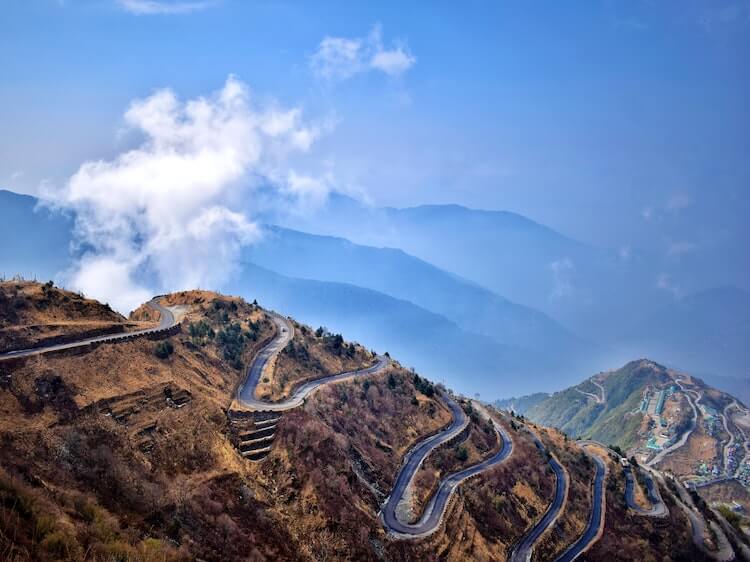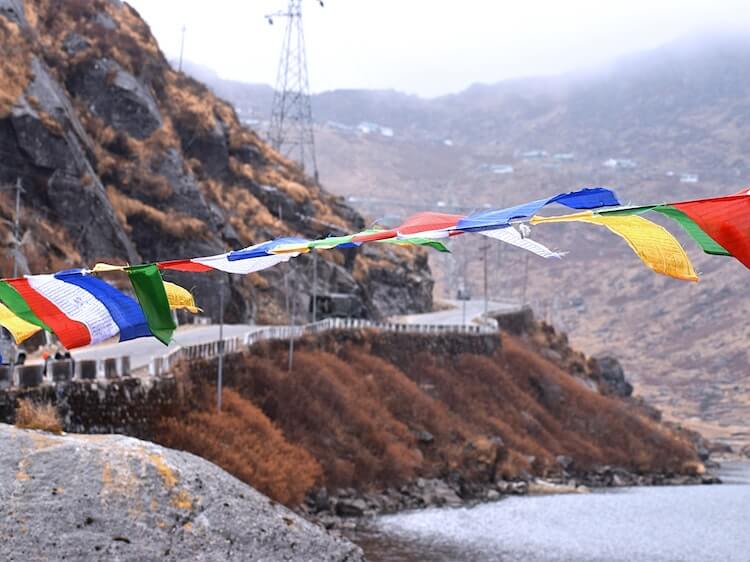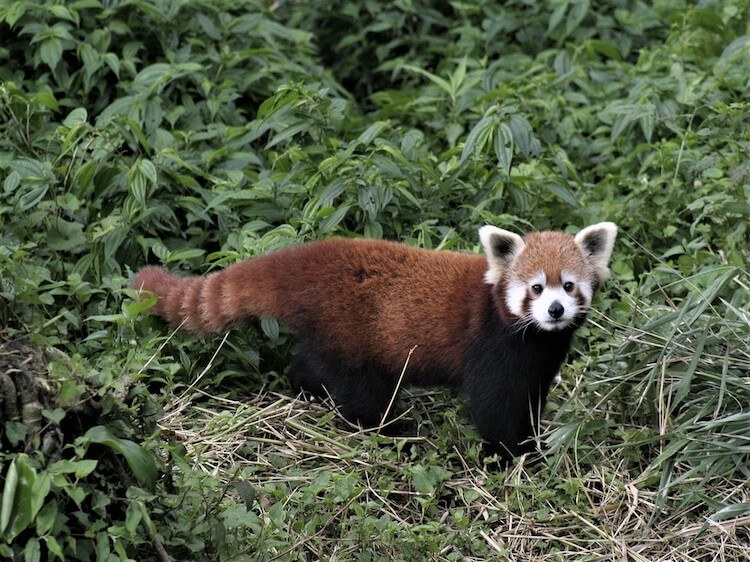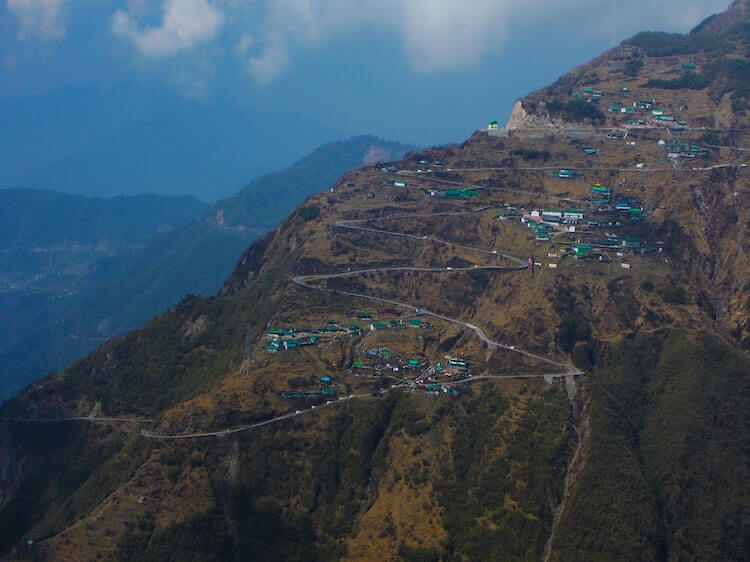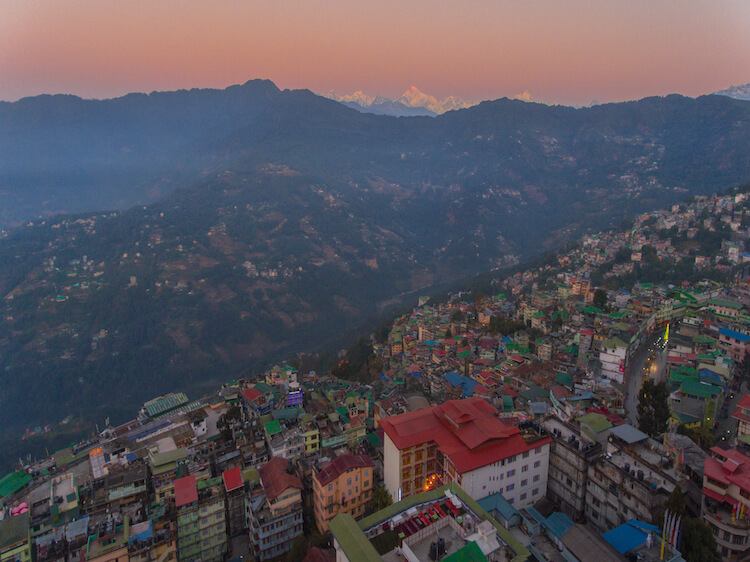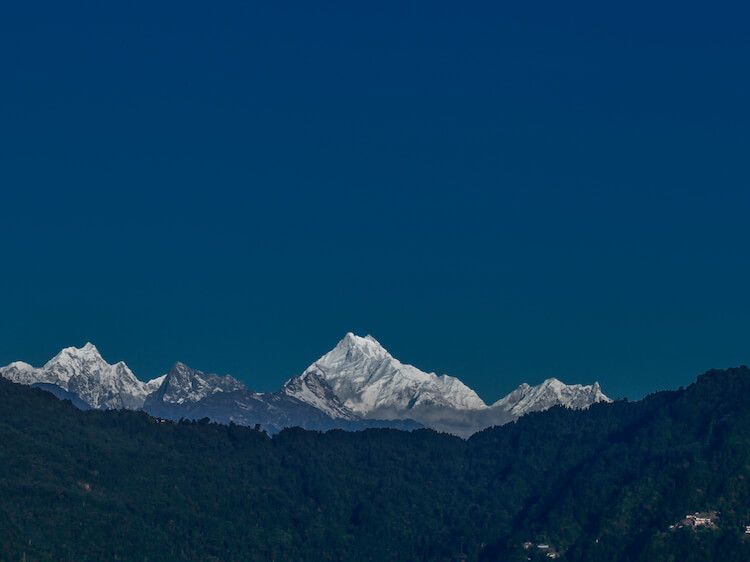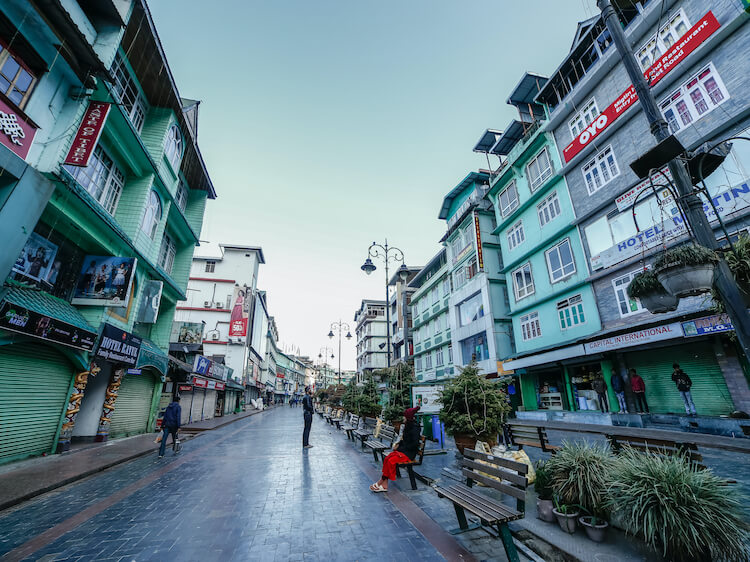Gangtok (East Sikkim)
Description
The east district is the most populated with Gangtok being the main administrative and business centre. Apart from the modern attractions of the capital town, the other interesting sites are beautiful Tsomgo Lake, the historically important Nathula pass, as well as many monasteries and temples.
Gantok, the fairytale capital of Sikkim in the clouds, balanced precariously on steep mountain slopes, surrounded by lush rice terraces, swift flowing, gurgling, foaming rivers and distant snow views, Gangtok reflects unique ambience which derives from its happy blend of tradition and modernity. Alongside the deeply felt presence of stupas and monasteries, Gangtok also bustles like any other town. But with many of this oasis of quite, those unexpected pockets of peace exists everywhere.
| - | - |
| Popular Places |
|
Places of interest in and around Gangtok (East Sikkim)
-
1Rumtek Monastery
The 24 km drive from the capital to Rumtek Monastery is, in itself, worth the effort. Changing vistas of mountains unfold at every bend and there are delightful vignettes of the hamlets and fields of the people of rural Sikkim. The original monastery was built by one of the rulers of Sikkim. When, however, His Holiness the late 16th Gyalwa Karampa left Tibet he built a new monastery, the Dharma Chakra Centre, reputedly replicating his former one. Thus, though the monastery is new, it enshrines all that is best in traditional Tibet monastic architecture. When seen in the clear light of Sikkim, this magnificent building with its red pillars, brilliantly painted fretwork and superbly glowing murals glitters like a jewel set in the green hills.
-
2Government Institute of Cottage Industries
It produces crafts in authentic Sikkimese designs from the entire state. Hand woven Tibetan carpets sprout dragon in natural dyes, Sikkimese-style tables called Choktse are expertly carved and richly coloured in red and gold. Hand-made rice paper is also produced here. Talented children are taught the art of knitting, weaving, leather work, basket making, mask making and painting of religious and secular themes.
-
3Institute of Tibetology
This organization is dedicated to furthering Tibetan studies, Buddhist philosophy and religion. The institute attracts the scholars from all over the world. It houses a rare collection of 30,000 books, Tantric documents, rare manuscripts written in gold on the bark of a poisonous tree, antique thangkha and 200 icons, all prized objects of art for the Buddhist world.
-
4Do-Drul Chorten
One of the most important stupas of Sikkim, it was built by Trulshi Rimpoche, head of the Nyingmapa order of Tibetan Buddhism, in 1945. Inside the stupa, there are complete mandala sets of Dorjee Phurba (Bajra Kilaya), a set of Kan-gyur relics (holy books), Zung (mantras) and other religious objects. Around the chorten, there are 108 Mani Lhakor (prayer wheels). These prayer wheels are turned by the devout Buddhist while chanting ‘Hail to the jewel in the Lotus’, to invoke the Boddhisattava. The chorten is surrounded by Chorten Lhakhang and Guru Lhakhang, where there are two huge statues of Guru Rimpoche (Guru Padmasambhava).
-
5Enchey Monastery
An important seat of the Nyingmapa order, the Enchey Monastery is built on the site blessed by Lama Druptob Karpo, a tantric master known for his power of flying. This 200-year-old monastery has in its premises images of gods, goddesses and other religious objects. Every year around January ‘Chaam’ or religious masked dances is performed here with great fanfare for two days.
-
6Tashi Viewpoint
About 8 km from Gangtok, this viewpoint offers fascinating view of the majestic Mount. Kanchenjunga and Mount. Siniolchu.
-
7Lal Bazaar
On Sunday, Gangtok’s Lal Bazaar is a melody of colour. Various ethnic groups from different villages gather to haggle, bargain, barter, gossip or just sell their wares.
-
8Deer Park
A small Deer Park near the Secretariat building enshrines an icon of the Buddha and provides an excellent view of the green hills and valleys.
-
9Orchid Sanctuary
Just below the Institute of Tibetology, it is a very specialized garden. According to Government Department, there are over 200 species of temperate and intermediate type orchids. Such orchids are best seen during the blooming season of April-May, July-August and October-November.
-
10Tsuklakhang (The Palace Monastery)
Located in the grounds of the palace of the former rulers, the Chogyals of Sikkim. Built in traditionally Sikkimese style, it is capital’s most accessible monastery and has interesting murals and images of the Buddhist pantheon.
-
11Orchidarium
In spite of its name, this is essentially a botanical garden in a green and landscaped fold in the hills. Paths wind down past streams, tree ferns and flower beds. At the bottom are enormous conservatories where masses of orchid plants thrive in their preferred environment.
-
12Ganesh Tok
‘Tok’ means temple in local language. Situated on a beautiful hilltop at an altitude of 6,500 feet above sea level, this vivid Hindu temple built in 1953 is one of the most popular Lord Ganesh temples in Gangtok. Located near Tashi Viewpoint, after a 7km of steep drive from the main town, on a clear day, the site offers panoramic view of Mount. Kanchenjunga and the Gangtok city. The colourful prayers flags hoisted along the route enhance the spiritual significance and landscape of the place. At the time of 10 days festival of Ganesh Chaturthi, special rituals and ceremonies performed here, adding further to the divinity of the place.
-
13Hanuman Tok
Hanuman Tok, the temple dedicated to Lord Hanuman is located near the Ganesh Tok which makes this a must-visit especially for the Hindu devotees. Legend has it that Lord Hanuman, the Monkey God, rested at the exact spot where the current temple lies, while flying with the Sanjeevani that eventually saved life of Lakshman, Lord Rama’s brother. This makes the temple a must-visit pilgrimage site for many. Situated 11km from Gangtok town at an altitude of 7,000 feet, the site is also popular because of its vantage point offering breath-taking view of Mount. Kanchenjunga. The temple is currently maintained by Black Cat Division of Indian Army. For a wholesome experience, one can also visit the adjoining Smriti Van to plant saplings in the memory of loved ones or to mark a special event.
-
14Tsomgo Lake
Located 38km from Gangtok, the literal meaning of Tsomgo is the source of the lake in Bhutia language (TSO means lake and MGO means head). This 1 km long lake is about 15 m deep and in shape of oval. It is considered extremely sacred by the local people. This placid lake remains frozen during the winter months.
The lake is a home to Brahminy ducks besides being a stopover for various migratory birds. En route to Tsomgo, numerous waterfalls, fast rushing mountain streams and the rhododendron rich Kyongnosla Alpine Sanctuary make this excursion all the more thrilling.
Sikkimese folklore tells the story of how Tsomgo initially at Laten, several km away from the present Tsomgo (lake) came to take present position: An old woman, one night dreamt that the lake at Laten was to shift to Tsomgo and she and her two other herder friends were warned, to leave the place as soon as possible. The old lady hastened to inform her friends, but they paid no heed. In turn, she hurriedly milked her dri (female yak) and poured the milk on the ground, as an auspicious sign and left the place for Lhachungkar near Thegu. Just before leaving, she happened to see an old lady with strikingly white hair and of fair complexion who was carding yarn, entered Tsomgo where immediately the earth turned into water and formed this Tsomgo (lake). The two yak herders are believed to be sub-merged in the lake along with their herd of yaks.
-
15Fambong La Wildlife Sanctuary
This sanctuary is located at a distance of 25 km from Gangtok and has an area of 51.76 sq. km. The main vegetation here is Oak, Katus, Kimbu, Champa with thick bamboo forests and ferns. The sanctuary is also home to large number of wild orchids, rhododendron etc. This area, being close to Gangtok is developed as a short trekking trial.
-
16Nathula
56 km from Gangtok is the Nathula pass at an alt. of 14,200 feet, bordering between India and China in the Tibetan plateau. It is one of the highest motorable roads and richly covered by various species of Alpine Flora and Fauna.
-
17Baba Mandir
The Baba Harbhajan Singh Temple is popularly known as Baba Mandir, located about 52 from Gangtok at an altitude of 12,123 feet, between Jelepla and Nathula pass.
The story behind the temple is indeed sentimental for many. Harbhajan Singh from Punjab Regiment was posted at China border as part of the border patrol force. It is said that in October 1968, he disappeared without a trace. Harbhajan Singh used to escort mules that carry provisions for the army and one version about his disappearance is that he could have fallen in a stream and drowned. A fellow sentry personnel had a dream about him after a few days and asking to construct a memorial in his name. The sentries build a tombstone and a few years later proper temple was constructed on it. It is believed that Harbhajan Singh’s spirit is still alive, and the army personnel pray and wish that Harbhajan Singh will protect them during any adversary. The soldiers in the camp, till the day, believe that Harbhajan Singh visits the camp every night to be part of the patrolling force. There were even instances where his polished shoes become dirty, and his neat camp bedsheet is crumpled by morning. Even after his death Harbhajan Singh got promoted to the rank of Honorary Captain and his family still receives a monthly salary. Also there have been rumours that the Chinese soldiers sighted a turbaned sentry walking around the borders, guarding the area on multiple occasions.
Over the years, the memorial has turned into a pilgrimage place and visitors worship the large photo of Harbhajan Singh inside the temple. Harbhajan Singh also has a dedicated office in the ground where he is believed to carry out his day-to-day activities. In it, there is a dining place, a bed, his shoes and uniform.
It is further believed that during the event of a war between India and China, Baba would warn the Indian soldiers of any impending attack at least three days in advance.
-
18Aritar
Located in east Sikkim, Aritar is steeped in history and natural beauty. A breath-taking view of Khangchendzonga adds to the many natural riches that Aritar is blessed with. Lush green forests, sweeping hills of paddy fields and placid lakes hidden inside deep forests makes it a perfect destination for those in search of nature trails and a serene holiday.
The Lampokari Lake surrounded by lush greenery is considered one of the oldest in Sikkim. A short trek leads one to Mankhim Dara, where a temple dedicated to the ethnic Rai community is located. Mankhim offers a 360 degree view of the surrounding areas. The Aritar Gompa is one of the oldest monasteries in Sikkim belonging to the Karma Kagyu lineage order of Tibetan Buddhism. Aritar also hosts the Lampokhari Tourism Festival during end of March and early April. For the more adventurous, there is rock climbing and paragliding too, which is guaranteed to keep travellers’ adrenaline rushing.
-
19Zuluk
Perched at a height of 3,300m above the sea level on the rugged terrain of the lower Himalayas in East Sikkim, Zulul or Dzuluk is a picturesque hamlet which used to be once the historic silk route from Tibet to India. It is relatively an emerging and offbeat destination in East Sikkim and blessed with panoramic vistas of ice capped mountains, deep gorges, dense woods and sparkling streams. The region offers excellent view of eastern Himalayan Mountain range including mighty Kanchenjunga. There is also an Indian Army base at Zuluk, which has been used as a transit camp for the army movement to the Chinese border, a few kilometres away. It is the very first village within this whole Silk Route circuit to offer home-stay facilities for tourists. Dzuluk is surrounded by wild virgin forest and sighting of Deer, Wild Dog, Himalayan Bear the red panda is not very uncommon. A variety of birds can also be seen such as Blood Pheasant, Himalayan monal, Kalij pheasant, Snow Pheasant and others. During the summer months, the area and its surrounding hills are covered with thousands of blooming rhododendrons.

